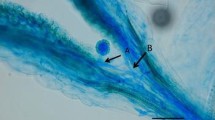Summary
Crossability between most Paspalum species is very low. This study was undertaken to identify the impediments to hybridization. Accessions of P. intermedium Munro. ex Morong, P. jurgensii Hackel and P. dilatatum Poir were self-pollinated and crossed with one anther. Paspalum intermedium is essentially self-sterile but P. jurgensii and P. dilatatum are highly self-fertile. Following pollination, pollen germination and tube growth were studied by observing the pollinated pistils with fluorescent microscopy. Examination of self-pollinated pistils revealed that the pollen germinated shortly after contacting the stigmas. Germination was over 80% for the P. intermedium and P. dilatatum accessions but only 57% for P. jurgensii. Pollen tubes grew to the micropyle within 45 minutes after pollination in P. dilatatum and 1 hour and 15 minutes in P. jurgensii. However, in the P. intermedium accessions most tubes did not grow beyond the stigma and very few penetrated the style and ovary. Apparently stylar-incompatibility is the reason for the low selfed seed set. In the cross-pollinations, pollen germinated shortly after pollination and germination ranged from 57 to 88% for the different crosses. In all crosses the pollen tubes grew to the micropyle within 30 minutes to 2 hours after pollination indicating that a cross-incompatibility system is not the cause for low crossability among these species. By examining embryo sacs from P. intermedium × P. dilatatum, its reciprocal and P. intermedium × P. urvillei crosses, it was determined that gametes failed to unite in some crosses and this is a major reason for low crossability.
Similar content being viewed by others
References
Bashaw, E. C. & Ian ForbesJr., 1958. Chromosome numbers and micrsporogenesis in dallisgrass, Paspalum dilatatum Poir. Agron. J. 50: 441–445.
Bashaw, E. C. & E. C. Holt, 1958. Megasporogenesis, embryo sac development and embryogenesis in dallisgrass, Paspalum dilatatum Poir. Agron. J. 50: 753–756.
Bashaw, E. C., A. W. Hovin & E. C. Holt, 1970. Apomixis, its evolutionary significance and utilization in plant breeding. pp. 245–248. In: M. J. T. Norman, (Ed.), Proc. 11th Int. Grassland Cong. University of Queensland Press. St. Lucia, Queensland, Australia.
Bennett, H. W. & E. C. Bashaw, 1960. An interspecific hybrid in Paspalum. J. Hered. 51: 81–85.
Bennett, H. W., B. L. Burson & E. C. Bashaw, 1969. Intra-specific hybridization in dallisgrass, Paspalum dilatatum Poir. Crop Sci 9: 807–809.
Burson, B. L., 1979. Cytogenetics of Paspalum urvillei × P. intermedium and P. dilatatum × P. paniculatum hybrids. Crop Sci. 19: 534–538.
Burson, B. L., 1981. Cytogenetic relationships between Paspalum jurgensii and P. intermedium, P. vaginatum, and P. setaceum var. ciliatifolium. Crop Sci. 21: 515–519.
Burson, B. L., 1983. Phylogenetic investigations of Paspalum dilatatum and related species. pp. 170–173. In: J. A. Smith & V. W. Hays (Eds), Proc. 14th Int. Grassland Cong. (Lexington, KY). Westview Press, Boulder, CO.
Burson, B. L., 1985. Cytology of Paspalum chacoense and P. durifolium and their relationship to P. dilatatum. Bot. Gaz. 146: 124–129.
Burson, B. L. & H. W. Bennett, 1970. Cytology and reproduction of three Paspalum species. J. Hered. 61: 129–132.
Burson, B. L. & H. W. Bennett, 1971. Meiotic and reproductive behavior of some introduced Paspalum species. J. Miss. Acad. Sci. 17: 5–8.
Burson, B. L. & B. A. Young, 1983. Pollen-pistil interactions and interspecific-incompatibility among Panicum antidotale, P. coloratum and P. deustum. Euphytica 32: 397–405.
Burson, B. L., H. Lee & H. W. Bennett, 1973. Genome relations between tetraploid Paspalum dilatatum and four diploid Paspalum species. Crop Sci. 13: 739–743.
Devine, T. E. & J. L. Starling, 1969. Impediments to hybridization of Phalaris arundinacea and P. tuberosa. Crop Sci. 9: 140–143.
Kho, Y. O. & J. Baer, 1968. Observing pollen tubes by means of fluorescence. Euhytica 17: 298–302.
Wilson, J. A. & E. C. Holt, 1960. Role of the male gametophyte in dallisgrass reproduction. Agron. J. 52: 134–137.
Author information
Authors and Affiliations
Rights and permissions
About this article
Cite this article
Burson, B.L. Pollen germination, pollen tube growth and fertilization following self and interspecific pollination of Paspalum species. Euphytica 36, 641–650 (1987). https://doi.org/10.1007/BF00041514
Received:
Issue Date:
DOI: https://doi.org/10.1007/BF00041514




